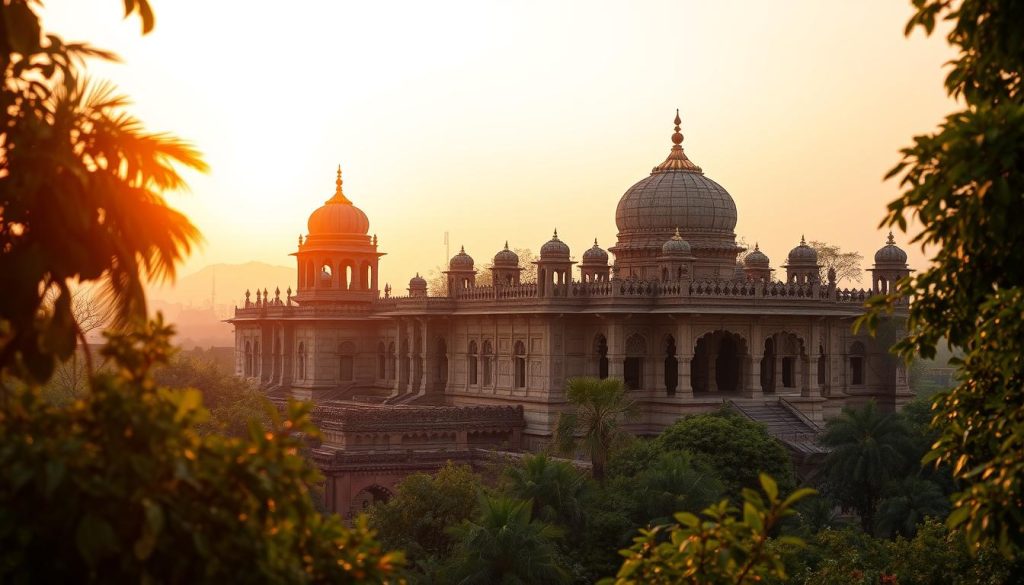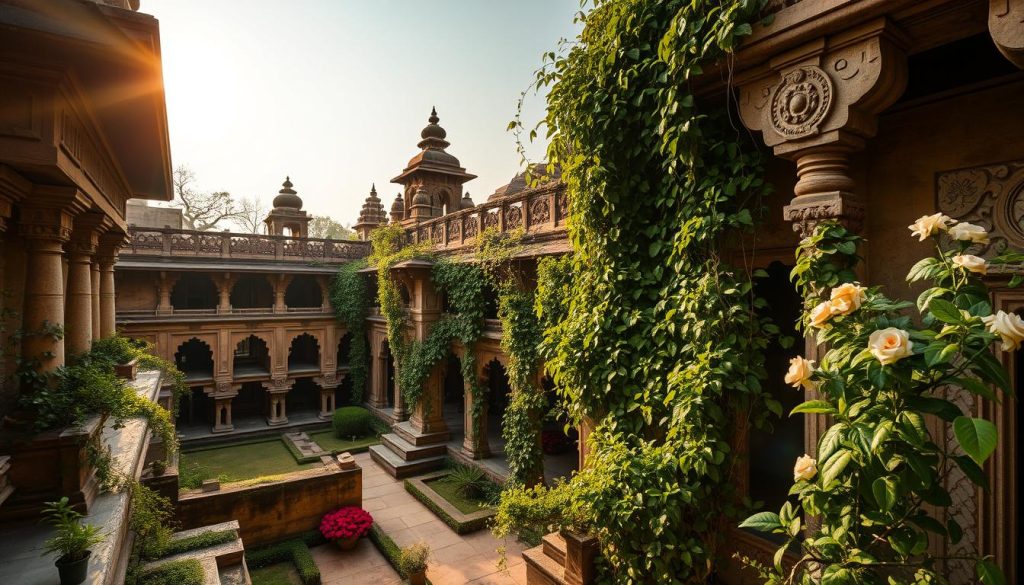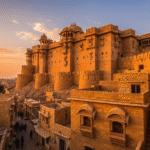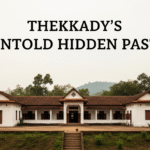In Karnataka, the city of Bijapur has many untold stories. It grows quietly, surrounded by history. Next to it, Bidar grows fast, showing how lively the area is. Yet, Bijapur’s history keeps its rich past alive. This city was once the center of the Adil Shahi dynasty. It holds many secrets and stories in its old ruins.
Bijapur shows the work of an ancient civilization. It’s home to the massive Gol Gumbaz and the beautiful Ibrahim Rauza. Here, rich farms support diverse life. The city’s crafts, like the old Bidri ware, show its culture. Bijapur sits importantly between Hyderabad and Mumbai, linked by road and rail.
Key Takeaways
- Bijapur’s past is etched with stories beyond its visible architecture and folklore.
- The Adil Shahi dynasty left an indelible mark on the city’s cultural and historical significance.
- Investigating Bijapur’s history is akin to embarking on a journey through time to unearth its hidden gems and forgotten accounts.
- The region’s traditional crafts, like Bidri ware, and historic monuments connect modern Bijapur with its illustrious heritage.
- Understanding Bijapur’s past is crucial to comprehending the intricate tapestry of Indian history and culture.
Unveiling Bijapur’s Mysterious Past
Exploring Bijapur reveals stories important to its cultural and historical background. The city is filled with huge architectural wonders. These reflect a mix of conflict, culture, and elegance that shaped Bijapur’s identity.
The Adil Shahi dynasty was central to Bijapur’s history. Their time brought political smarts and a mix of building styles. Today, Gol Gumbaz and Ibrahim Rauza tell us about the peak of Indo-Islamic architecture.
Looking into Bijapur shows its key role in history. It was not just politically important. The city was also a center for culture and learning. This attracted scholars from everywhere.
| Monument | Construction Period | Notable Features |
|---|---|---|
| Gol Gumbaz | 1626-1656 | Second largest dome globally, echoing whispers across its vast hall |
| Ibrahim Rauza | 17th century | Exemplary Indo-Islamic architecture with detailed carvings |
| Jumma Masjid | Completed in the 17th century | Serves as a monumental example of Islamic architecture in India |
| Malik-e-Maidan | Undated | Famed for housing the largest medieval cannon |
These big buildings are more than places to visit. They are key parts of Bijapur’s history. Each part of them tells a story of Bijapur’s hidden past.
The hidden past of Bijapur is really interesting. Looking closer at these stories and places helps us understand the city’s big, yet quiet, part in India’s history.
The Architectural Marvels of Bijapur
Exploring Bijapur’s architecture shows a city filled with stories of the past and great art. The Adil Shahi rulers from the 15th to 17th century made the city special. They left amazing things for people who love Bijapur historical secrets and Bijapur architectural gems.
Adil Shahi Dynasty’s Contribution
The Adil Shahi loved art and buildings. This love can be seen in many city monuments. These places show incredible building skills and beauty from their time. They remind us of the dynasty’s love for culture and new building ideas.
Gol Gumbaz: A Historical Giant
Gol Gumbaz is famous for its big dome and special sound effects. The dome is one of the largest and shows great engineering. Its whispering gallery is amazing. Sounds can be heard clearly over great distances.
Ibrahim Rauza: The Inspiration for Taj Mahal?
Ibrahim Rauza is a beautiful mosque and tomb. It’s known for its design and fine carvings. Some people think it inspired the Taj Mahal. This link shows its big importance in art and history. It makes Bijapur an important place in history books. See its beauty here.
Bijapur’s beauty and its buildings are very important in history studies. Each building tells us about the past and the people back then. Famous places like Gol Gumbaz and Ibrahim Rauza are loved by many. They are important for students, builders, and visitors.
Bijapur’s old buildings are a must-see. They invite everyone to see their beauty and learn about India’s great building history.
The Lost Tales from the Adil Shahi Courts
Exploring the Bijapur historical significance, we find rich stories. The Adil Shahi courts blend grand tales, diplomacy, and culture. They shaped Bijapur’s role in Indian heritage. These courts were not just political. They were centers of art and culture too.
By uncovering these stories, we learn about people and events. This offers deep insights into the interactions of cultures. The influences of these stories go beyond simple curiosity.
The Adil Shahi courts spurred artistic creativity. They mixed different traditions. This created a unique cultural identity that is still important today.
| Event | Description | Impact on Indian Heritage |
|---|---|---|
| Foundation of the Asiatic Society | Established in 1784, aimed at researching the arts and sciences of Asia. | Expanded the academic understanding and preservation of Asian cultures, including those influenced by the Adil Shahi courts. |
| Evolution of Indian Art | Integration of various art forms from different dynasties, including murals and miniatures. | Showcases the versatility and adaptability of Indian artistic traditions under influences like those from Bijapur’s courts. |
| Cultural Synthesis | The blending of native and foreign traditions at the court. | Enabled the emergence of a distinct cultural identity, influencing regional art, language, and social customs. |
The courts supported the arts. We see this in their stunning architecture and art. These works show the Adil Shahi’s impact on culture. They reveal the vibrant life and influence of the courts.
The historical significance of Bijapur shines through its culture and politics. The Adil Shahi dynasty made Bijapur significant in Indian heritage. This makes their story captivating.
Hidden history of Bijapur
The hidden depths of Bijapur’s past hold Bijapur unknown facts. These facts tell stories and share history now coming to light. This section looks at the less known stories and quiet histories of Bijapur beyond its famous sites.
The Forgotten Chronicles
Historians exploring Bijapur found links to Gondwana, a supercontinent over 200 million years old. These findings show Bijapur’s deep geological and historical importance. They suggest a complex past beyond normal history. Studies reveal ancient centipedes from Indian Scutigeromorpha trace back to Gondwana. This suggests Bijapur had rich biodiversity long ago.

The Bijapur Historical Secrets Revealed
Studies on Bijapur historical facts revealed uncover political stories and governance issues. For example, a story involves a blocked attempt to start a forestry and horticulture college due to government actions. This shows the complex administrative history of Bijapur. Such incidents provide new views on Bijapur’s governance rarely discussed before.
| Event | Impact on Bijapur |
|---|---|
| Alleged governmental hindrance in college establishment | Delayed educational development |
| Controversial remarks by the Speaker | Political unrest and criticism |
| Defending the constitutionality of appointments in court | Financial burden and legal disputes |
So, as we learn more, a different Bijapur appears from these tales and secrets. It’s a city with a rich geological and political history, ready for us to explore and fully understand.
Bijapur’s Lesser-Known Historical Significance
Beyond the famous Gol Gumbaz and Ibrahim Rauza, Bijapur hides many lesser-known historical treasures. These treasures have shaped both the local and national history of India. Bijapur’s deep history isn’t just about big structures. It’s also about its impact on Indian heritage. This makes Bijapur a great place to explore historical discoveries that many people don’t know about.
Strategic Importance Through the Ages
Bijapur was very important in the Deccan plateau. It was central for trade and defense through many dynasties. Its location made it key for both trade routes and military actions. This made Bijapur a major part of Indian history.
The city played a big role in historical conflicts and alliances. This makes its historical stories even more important. It shows Bijapur’s wide impact beyond just where it is on the map.
Bijapur’s Impact on Indian Heritage and Culture
Bijapur deeply influenced India’s culture, from music and buildings to government. This happened during the Adil Shahi dynasty. The city’s culture mixed Persian, Turkish, and local traditions. This mix helped make India’s heritage more varied.
The way buildings were designed and cities were planned back then are good examples. These designs and plans are part of Bijapur’s rich history. They continue to influence us today.
Bijapur was more than a place for kings and battles. It was a melting pot of culture and social exchange. This helped shape the wider civilization of India. Bijapur’s stories about art, culture, and politics help us understand its big role in India’s past.
| Feature | Details | Significance |
|---|---|---|
| Gol Gumbaz | Largest dome second only to St. Peter’s Basilica | Architectural innovation and acoustical phenomenon |
| Ibrahim Rauza | Known as the ‘Taj Mahal of the Deccan’ | Association with Indo-Islamic aesthetic and cultural syncretism |
| Asar Mahal | Used as a hall of justice | Importance in the socio-political and religious history of the region |
Bijapur’s heritage includes many historical and cultural treasures. These treasures are waiting to be more explored and recognized. They don’t just teach us about Bijapur’s past. They also help us value its role in today’s Indian culture and history.
Discoveries Shedding Light on Bijapur’s Hidden Gems
Recent digs in Bijapur have revealed many Bijapur hidden gems. These shine a light on its rich history. Artifacts and buildings show the skills of people long ago.

Items from the Adil Shahi era tell us how people back then lived. We learn about their food and crafts. The buildings found show they knew a lot about making things beautifully.
| Feature | Description | Significance |
|---|---|---|
| Gol Gumbaz | World’s second largest dome, known for its unique acoustic features. | Architectural and acoustic marvel attracting scholars and tourists. |
| Construction Era | Began in the mid-17th century during Mohammed Adil Shah’s rule. | Represents the culmination of Adil Shahi architectural ingenuity. |
| Whispering Gallery | Height of nearly 110 feet; echoes whispers up to 10 times. | Showcases the advanced understanding of acoustics by 17th-century engineers. |
These finds make Bijapur’s history even richer. They draw attention from locals and scholars. This keeps Bijapur’s story alive and interesting. The discoveries of Bijapur’s hidden gems teach and inspire us all.
Bijapur’s Role in the Deccan’s Turbulent History
Bijapur is in Karnataka, India. It is important in Indian history. It saw many battles and was a cultural hub. The city was at the center of conflicts and growth. This made it very important in history.
Conflict and Conquest: A History of Battles
Bijapur had many battles. These fights changed the area’s politics. The city was powerful in the region. The wars left a big mark on India’s history.
Trade and Culture Interchanges in Bijapur’s History
Bijapur was busy with trade and culture. Markets had traders and goods from many places. This trade brought different cultures together. Bijapur’s buildings, food, and languages show this mix of cultures. It was a very important city in Indian heritage.
Chronicles of Bijapur’s Unknown Facts
Bijapur is a city filled with untold stories from the past. It has many secrets that make its history more interesting. Discovering these stories can give us a better understanding of Bijapur’s importance in India.
Royalty and Intrigue: The Behind-the-Scenes Stories
The stories of Bijapur’s kings are full of secret plots. One interesting story is about Shivaji and Afzal Khan in 1659. This battle showed Shivaji’s smart thinking. It weakened Bijapur’s power, adding drama to its royal history.
Sacred Sites of Bijapur: Stories Etched in Stone
Bijapur is known for its many holy places. The Gol Gumbaz is one special site. It was built between 1626 and 1656. Its dome is among the world’s largest. The place has a whispering gallery where sounds echo in a magical way. This combines architecture with interesting stories.
Learning these stories about Bijapur makes visiting more meaningful. It also helps us appreciate the city’s role in India’s history. Bijapur shares its unique past and lasting impact through these stories.
Examining Bijapur’s Historical Significance in India’s Narrative
To grasp Bijapur’s historical significance, we need to look at its monuments. Each one holds special stories of the past. Icons like Gol Gumbaz and Ibrahim Rauza highlight artistic triumphs. They show the social and political forces of their times in India.
Looking into Bijapur’s history in the Indian narrative shows us something big. The city’s buildings draw in people who love history from everywhere. Places like the Jumma Masjid and Malik-e-Maidan tell us about Bijapur’s rich history and smart city planning back in the Sultanate era.
| Monument | Historical Period | Key Features | Implications on Bijapur’s Historical Narrative |
|---|---|---|---|
| Gol Gumbaz | 17th century | World’s second-largest dome, whispering gallery | Symbol of Bijapur’s architectural prowess and drawing global attention to its historical relevance |
| Jumma Masjid | Constructed during Adil Shahi Dynasty | Spacious courtyard, grand domes, intricate carvings | Reflects the melding of cultural and religious influences in the Deccan region |
| Ibrahim Rauza | 17th century | Intricate carvings, twin buildings, elegant domes | Often referred to as the inspiration for the Taj Mahal showcasing Bijapur’s contribution to later architectural styles in India |
When we compare Bijapur’s historical significance with places like Hyderabad, we see more. Bijapur shines as an important part of the Deccan’s history and culture. It adds beautiful stories to India’s broader narrative with its grand places and legacy.
The many ways people interact with these monuments keep Bijapur’s story alive in India’s history. It confirms its place as a key figure in the nation’s cultural and historical identity.
Conclusion
Our journey ends, but Bijapur’s story, filled with architectural beauty, remains. We found many things. These discoveries show us Bijapur’s secret history and its part in India’s cultural growth. The Asiatic Society of Bengal highlights the joy of exploring history. It connects past and present. This lets us see how Bijapur was shaped.
Bijapur, where Shah Jahān lived, shows the Mughal Empire’s glory. As the city watched empires change, it kept its spirit. Its buildings and stories tell of its strength. The Asiatic Society helped us learn about Bijapur’s important past and culture. Our journey uncovers Bijapur’s role in India’s rich history.
Bijapur’s mysteries and history continue to charm us. Its stories, now known, help us understand its importance. Our visits to the Ibrahim Rauza and Gol Gumbaz remind us discovery is unending. This journey deepens our love for Bijapur’s historical significance in India.
FAQ
What are some of Bijapur’s hidden historical discoveries?
Bijapur reveals secrets from the past. This includes artifacts from the Adil Shahi times. Lesser-known buildings show old engineering skills. Research and archaeology keep bringing new stories to light.
Can you name some hidden gems of Bijapur?
Yes, Bijapur has lots of hidden gems. The Malik-e-Maidan cannon, the Asar Mahal, and the Jami Masjid are examples. These places show the area’s rich past and importance in Indian history.
How has Bijapur’s history been revealed over time?
Its history is revealed through research, digs, and preserving old buildings. Studying texts and folklore helps too. Technology and interest in its past have uncovered many secrets.
What is the significance of the Adil Shahi dynasty’s contribution to Bijapur?
The Adil Shahi dynasty shaped Bijapur from the 15th to the 17th century. They built famous structures like the Gol Gumbaz. They blended cultures, promoted arts, and left a lasting mark.
How does the Gol Gumbaz represent Bijapur’s historical architecture?
The Gol Gumbaz showcases Adil Shahi’s architectural talent. It’s known for its huge dome and the ‘Whispering Gallery’. It symbolizes Bijapur’s historical grandeur and remains an architectural wonder.
Is it true that Ibrahim Rauza served as inspiration for the Taj Mahal?
It is thought that Ibrahim Rauza might have inspired the Taj Mahal. Their design and use of white marble are similar. Both have beautiful gardens and detailed stone work.
What truths do the forgotten chronicles of Bijapur uncover?
They uncover many truths about Bijapur’s people, politics, and court life. It shows how power, culture, and outside influences shaped the city.
What secrets have recent Bijapur historical secrets revealed?
New secrets tell us about court plots, military tactics, and how the city was run. Finds have shown us the city’s defense, trade, and the people’s lives, revealing more about Adil Shahi times.
What was the strategic importance of Bijapur throughout history?
Bijapur was super important due to its spot in the Deccan region. It was a tough fort, a trade hub, and a cultural center. It was key for many kingdoms and empires.
How does uncovering Bijapur’s mysteries contribute to our understanding of Indian heritage and culture?
Digging into Bijapur’s past helps us understand India’s heritage better. It shows us how different areas and dynasties connected. It also teaches us about India’s diverse cultures and its complex history.
What can recent discoveries in Bijapur teach us about the region’s past?
These discoveries show us about its mix of architectural styles and urban and water systems. We learn about how people lived, their beliefs, and the economy back then. These findings highlight the creativity and wisdom of the Adil Shahi era.










